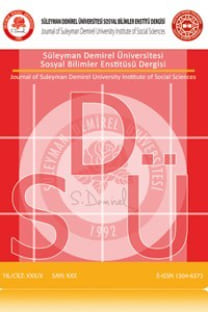TÜRKİYE VE BRICS ÜLKELERİNİN BİLGİ VE İLETİŞİM TEKNOLOJİLERİ GELİŞMİŞLİK ENDEKSLERİ İLE LOJİSTİK PERFORMANS ENDEKSLERİNİN KARŞILAŞTIRILMASI
Ülkelerin lojistik performanslarının uluslararası ticarette bir belirleyici olduğu ve rekabet üstünlüğü sağladığı yapılan çeşitli araştırmalarda ortaya konmuştur. Bu doğrultuda geliştirilen lojistik performans endeksi lojistik sistemlerin verimliliğini ölçmekte ve ülkeler arası kıyaslama yapmaya olanak sağlamaktadır. Organizasyonlar ve ülkeler için önemi büyük olan bir başka etmen ise bilgi ve iletişim teknolojilerine erişim ve bu teknolojilerin etkin kullanım düzeyleridir. Bilgi ve iletişim teknolojilerindeki gelişme düzeylerinin lojistik performans gibi birçok faaliyette önemli olduğu ve etkin kullanımının rekabet avantajı sağladığı bilinmektedir. Buradan yola çıkarak araştırmada öncelikle Türkiye’nin ve yükselen ekonomiler olarak değerlendirilen BRICS ülkelerinin lojistik performans endeksleri ile bilgi ve iletişim teknolojileri gelişmişlik endeksleri kıyaslanmıştır. Ardından SPSS programı aracılığıyla fark analizi gerçekleştirilmiştir. Elde edilen sonuçlarda ülkelere göre her iki endeksin alt boyutları bazında anlamlı farklılıkların olduğu görülmüştür
Anahtar Kelimeler:
Lojistik performans endeksi, bilgi ve iletişim teknolojileri gelişmişlik endeksi, Türkiye, Brics Ülkeleri
___
- ARVIS, J. F., OJALA, L., WIEDERER, C., SHEPHERD, B., RAJ, A., DAIRABAYEVA, K., ve KIISKI, T. (2018). Connecting to compete 2018: trade logistics in the global economy. The World Bank.
- BAYRAKTUTAN, Y., ve ÖZBİLGİN, M. (2015). Lojistik Maliyetler ve Lojistik Performans Ölçütleri. Maliye Araştırmaları Dergisi, Yıl:1, Cilt:1, Sayı:2, 95-112.
- BIGGEMANN, S., ve FAM, K. S. (2011). Business marketing in BRIC countries. Industrial Marketing Management, 40(1), 5-7.
- BLOOM, N., GARICANO, L., SADUN, R., ve VAN REENEN, J. (2014). The distinct effects of information technology and communication technology on firm organization. Management Science, 60(12), 2859-2885.
- BURMAOGLU, S., ve SESEN, H. (2011). Analyzing the dependency between national logistics performance and competitiveness: Which logistics competence is core for national strategy?. Journal of competitiveness, 3(4). 04-22.
- BYRD, T. A., ve DAVIDSON, N. W. (2003). Examining possible antecedents of IT impact on the supply chain and its effect on firm performance. Information & Management, 41(2), 243-255.
- CAN, A. (2017). SPSS ile bilimsel araştırma sürecinde nicel veri analizi (5.Baskı). Ankara: Pegem Akademi Yayıncılık.
- CHAPMAN, R.L., SOOSAY, C. ve KANDAMPULLY, J. (2003), “Innovation in logistic services and the new business model”,International Journal of Physical Distribution & Logistics Management, Vol. 33 No. 7, pp. 630-650.
- CHRISTOPHER, M. (2005). Logistics and supply chain management: creating value-adding networks. Financial times series. FT Prentice Hall, Upper Saddle River.
- DE MARCHI, V., DI MARIA, E., ve GEREFFI, G. (EDS.). (2018).Local clusters in global value chains:Linking actors and territories through manufacturing and innovation. London: Routledge.
- DİLEK, Ş., İSTİKBAL, D., ve YANARTAŞ, M. (2018). Küresel Ekonomide Yeni Bir Güç Odağı:“BRICS”. Seta Yayınları.
- FARHADI, M., SALEHI, H., EMBI, M. A., FOOLADI, M., FARHADI, H., AGHAEI-CHADEGANI, A., ve ALE-EBRAHIM, N. (2013). Contribution of Information and Communication Technology (ICT) in Country’s H-Index. Journal of Theoretical and Applied Information Technology,57, 1-8.
- HAMEED, U.H., SHABBİR, M.S., RAZA, A., ve SALMAN, A. (2019). Remedies of low performance among Pakistani e-logistic companies: The role of firm’s IT capability and information communication technology (ICT). Uncertain Supply Chain Management, 7 (2), 369-380.
- INTERNATIONAL TELECOMMUNICATION UNION (ITU) (2018). Measuring the information society reports: 2018.
- INTERNATIONAL TELECOMMUNICATION UNION (ITU). https://www.itu.int/en/ITU-D/Statistics/Pages/publications/mis2007.aspx. Erişim Tarihi: 15.09.2020 .
- JAYARAM, J., VICKERY, S.K. ve DROGE, C. (2000), “The effects of information systeminfrastructure and process improvements on supply-chain time performance”,InternationalJournal of Physical Distribution & Logistics Management, Vol. 30 Nos 3/4, pp. 314-30.
- MANSELL, R. (1999) GAIT- global access to information & communication technologies: priorities for action. INK@SPRU, International Development Research Centre (IDRC), Sussex, UK.
- MARTI, L., MARTIN, J. C., ve PUERTAS, R. (2017). A DEA-logistics performance index. Journal of applied economics, 20(1), 169-192.
- MARTI, L., R. PUERTAS ve L. GARCIA (2014), “The Importance of the Logistics Performance Index in International Trade”, Applied Economics, Vol. 46, No. 24, pp. 2982-2992.
- NADEEM, S., ALVI, A. K., ve IQBAL, J. (2018). Performance indicators of e-logistic system with mediating role of Information and Communication Technology (ICT). Journal of Applied Economics & Business Research, 8(4), 217-228.
- POKHAREL, S. (2005). Perception on information and communication technology perspectives in logistics: A study of transportation and warehouses sectors in Singapore. Journal of Enterprise Information Management, 18(2), 136–149.
- RADULESCU, I. G., PANAIT, M., ve VOICA, C. (2014). BRICS countries challenge to the world economy new trends. Procedia economics and finance, 8, 605-613.
- REZAEI, J., VAN ROEKEL, W. S., ve TAVASSZY, L. (2018). Measuring the relative importance of the logistics performance index indicators using Best Worst Method. Transport Policy, 68, 158-169.
- RUSHTON, A., CROUCHER, P., ve BAKER, P. (2014). The handbook of logistics and distribution management: Understanding the supply chain (5th Edn). Kogan Page Publishers.
- SAURA, I.G., FRANCE ́S, D.S., CONTRI, G.B. ve BLASCO, M.F.(2008), “Logistics service quality: a new way to loyalty”,Industrial Management and Data Systems, Vol. 108 No. 5,pp. 650-68.
- THE WORLD BANK, https://lpi.worldbank.org/international/global (Dünya Bankası), Erişim Tarihi: 15.09.2020.
- TOH, K. T. K., NAGEL, P., ve OAKDEN, R. (2009). A business and ICT architecture for a logistics city. International Journal of Production Economics, 122(1), 216-228.
- YOSHIMOTO, R., ve NEMOTO, T. (2005). The impact of information and communication technology on road freight transportation. IATSS research, 29(1), 16-21.
- ZHANG, X., PIETER VAN DONK, D. ve VAN DER VAART, T. (2011), "Does ICT influence supply chain management and performance? A review of survey‐based research", International Journal of Operations & Production Management, Vol. 31 No. 11, pp. 1215-1247.
- Yayın Aralığı: Yılda 3 Sayı
- Başlangıç: 2005
- Yayıncı: Süleyman Demirel Üniversitesi
Sayıdaki Diğer Makaleler
EKONOMİK VE FİNANSAL ÜLKE RİSKLERİNİN PAY FİYATLARI OYNAKLIĞINA ETKİSİ
OECD ÜLKELERİNDE İNOVASYONUN EKONOMİK BÜYÜME ÜZERİNDE ETKİSİ: SCHUMPETER HAKLI MI?
Bahattin HAMARAT, Özge UYSAL ŞAHİN, Hakan KEVŞEK
YERLİ VE MİLLİ SOSYAL MEDYAYI TERCİH ETME NEDENLERİ
OTİZMLİ ÇOCUĞU OLAN AİLELERİN SOSYAL DIŞLANMASINI ÖNLEYİCİ- BİR SOSYAL İÇERME ÖRNEĞİ
Kerem KARABULUT, Hikmet AKYOL, Kübra KARAKUŞ
ÖNLİSANS ÖĞRENCİLERİNİN SOSYO-DEMOGRAFİK ÖZELLİKLERİNE GÖRE BOŞ ZAMAN YÖNETİMİ
